An examination of the main changes in Japanese HRM over the past 10 – 20 years, as well as highlighting the driving forces that brought about these changes.
Introduction
The bursting of the “economic bubble” in the late 1980s and early 1990s, together with fundamental changes in the business environment, has made the Japanese economy alternate between periods of Heisei recession, which in turn has seriously affected employment (Benson and Debroux 2004) (see Table 1). The irony of Japanese economic decline is that its HRM model, a key competitive advantage and characteristic admired by western economies, became a threat to its survival. For an economy based on and accustomed to high growth, with companies like Toyota and Toshiba leading global markets for automobiles and electronics, the largest obstacle was a lack of sense of crisis among firms and their employees (BBC 2001). They believed their traditional management practice, which had led to earlier economic success, would see them through the recession. Nonetheless, many companies soon realised the necessity of restructuring their human resources management practices to attain market oriented flexibility in order to survive global competition. Despite the westernisation of Japanese management, firms remain keen on maintaining the strengths of the Japanese system (Sano, 1998; Haak, 2006; Dedoussis,2001;Hanami, 2004).
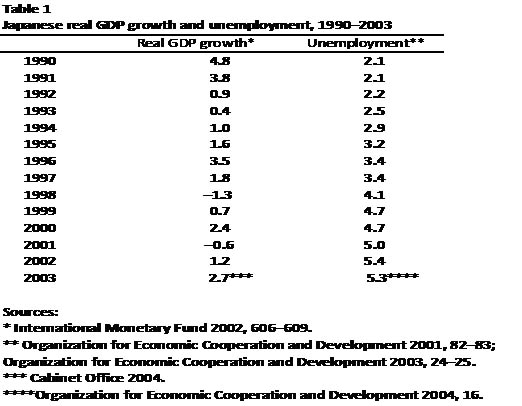
This essay examines the main changes in Japanese HRM over the past 10 – 20 years, as well as highlighting the driving forces that brought about these changes. However, for a clearer understanding of these changes, I will begin by giving an overview of the traditional Japanese HRM Model.
Traditional Japanese HRM Model
Japanese human resources management is essential to understanding the post second world war economic growth of Japan, which made its economy the second largest in the world, despite its lack of natural resources (Salmon, 1999). The paternalistic HRM model was built around the Japanese cultural ‘Confucian’ values and the diffusion of its system of ‘alliance capitalism’. These values resulted in greater emphasis on moral rather than economic/market values, which is why the subject of corporate governance in Japan often indicated that managers identify more with employees and are quick to disregard shareholder interest (Salmon ; Sano, 2004).
Life time employment (shushin koyo), seniority plus merit (nenko) pay and enterprise unions (kigyo-nai kumiai) formed the “three pillars” (sanshu no jingi) (Selmer, 2001). Shushin koyo and nenko are the most distinctive features of Japanese HRM, creating a platform for long-term development of company specific skills ( Salmon, …….).
Though these employment practices never covered the majority of the workforce, it was the desired norm in Japanese public debate (OECD 1973; Berggren and Nomura, 1997).
Abegglen and Stalk (1985:199) provide a western view of the ‘Japanese Employment System’. Firstly, the employee is hired directly from school rather than from an open job market. Secondly, he is hired for his general characteristics and abilities rather than for a particular skill or job. Thirdly, he is expected to remain with the company for a life–long career and in turn expects not to be laid off or discharged.
Dore (1973) terms the Japanese firm as a ‘community’ in which a mutually beneficial relationship exists between employer and employee. He reinforces this with the term ‘welfare corporatism’, the provision of employment security and welfare by the firm. The worker in turn feels a sense of ‘community consciousness’ which makes him committed to the firm. Fig 1 below shows the structure of relationships between the philosophy, strategy, policies and practices, behavioural outcomes and ultimate outcomes of the traditional Japanese human resources management system.
It is important to note that the commitment of firms to this model was encouraged by the lengthy period of economic growth, legal verdicts in the 1950s and 1960s placing restrictions on employee dismissal, 1970s civic policy schemes encouraging employment security, and union confrontation (Cole, 1973; Hanami, 1994; Kume, 1998; and Moore, 1983). However, now that Japan is no longer able to maintain the dynamic growth of previous decades, firms are beginning to reconsider their human resources practices.
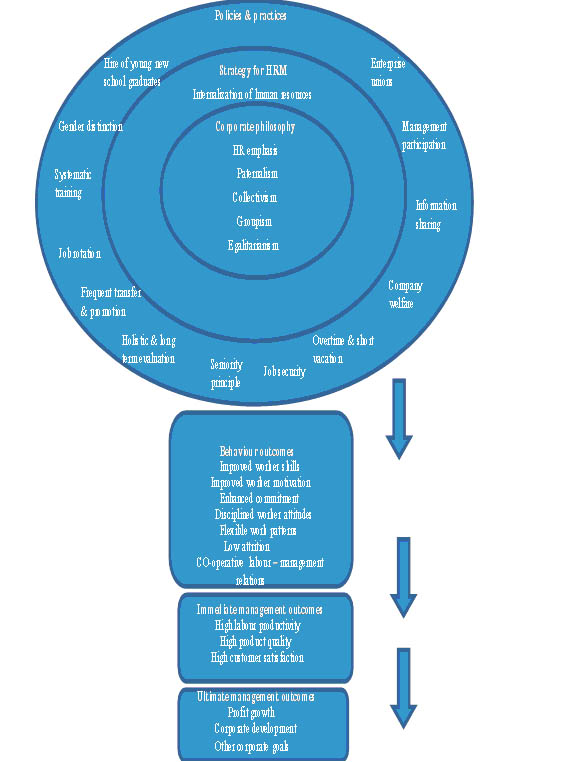
Figure 1 The Human Resource Management System of Japanese Corporation Source: Sano in IEBM 1998
Changes in Human Resources Management
I would be exploring the changes in lifetime employment, recruitment, human resources development, compensation systems, decision making, workforce diversity, unions and the role of the state.
Life time employment Adjustment
The economic crisis threw lifetime employment into question, as many firms could no longer assure employment protection. However, this remains a target for most companies. In a study by the Ministry of Labour (1995a:88) 51% of manufacturers hoped to ‘maintain shushin koyo in principle, while 43.3% believe that minor changes are inevitable. In order to retain the life time employment principle, the Ministry of Labour statistics show that firms have now developed a more flexible approach by using one or more of the following: reducing overtime (23%), intra (10%) and inter (8%) firm transfers, suspension of work (4%), and ‘early retirement’ (soki taishoku) (4%) as opposed to dismissal (kibo taishoku), which is usually the last resort. Companies avoid the latter because it will lose consumers’ trust and this in turn will lead to declining demand (Berggren and Nomura, 1997; Lincoln and Nakata, 1997). An example of the use of this approach was the situation in Mazda in the 1990s when the company was losing $1million a day. In order to cut labour costs, the management resorted to early retirement and temporary pay cuts, which was a great relief to the union, who thought employees would be fired (BBC, 2001).
Recruitment
One way companies have sought to increase labour flexibility and reduce overhead costs has been to hire more non-regular workers, such as part-time or temporary workers (directly and via agencies), who can be easily dismissed during economic downturns (Sato, 2001; Osawa, 2001). Labour surveys indicate an increase in the number of workers covered by fixed–term contracts from 910,000 in 1992 to more than 2,000,000 in 2001; 12 million part-time workers (fewer than 35 working hrs/week) signifies an increase in the share of the total workforce. Part-time workers increased from 10% in 1980 to 22.8 % in 2001 (Hanami, 2004). This explains the reason for a 3.7% decrease in full time workers between 1996-2001(Ministry of Health, Labour and Welfare, 2002).
The increasing need for continuous innovation to remain competitive has led to a change in recruitment on the basis of general abilities to professional and specialist skills. For example, Mazda brought in an experienced American manager to help revive the company when it became apparent that Japanese management lacked the expertise to revive company fortunes (BBC, 2001). However, companies still maintain an influx of new graduates in order to stay ahead in the talent war (Selmer, 2001).
A survey of the diversification of employment status gives an employers view on the use of hiring non-regular workers. See Table 2
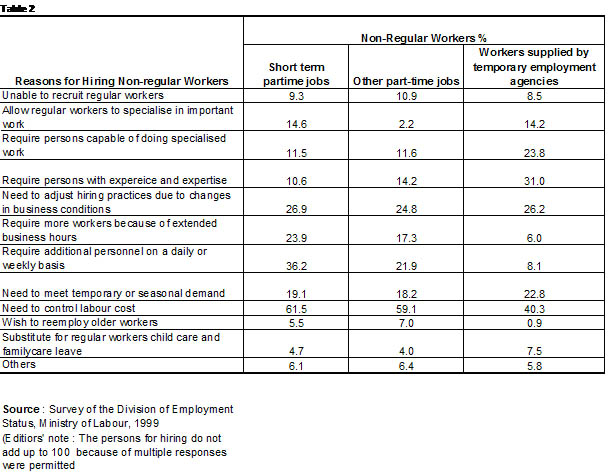
Nikkeiren also suggests a new HRM model that would help retain lifetime employment, as well as giving firms some form of flexibility (Nikkeiren, 1995). They propose three pools of employees.
Pool 1: Core employees with long term tenure and guaranteed career prospects
Pool 2: Employees with specialist skills relevant for immediate use with fixed employment
Pool 3: Highly fluid employees who perform routine tasks
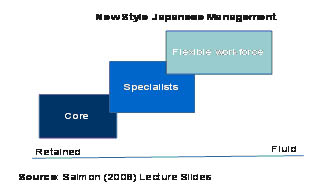
Globalisation has also given large firms, the opportunity to take advantage of cheap labour by outsourcing part of their operations abroad to countries such as China and India (Ministry of Labour, 1996).
Human Resources Development
This use of on the job training (OJT) during the boom era was particularly useful because most Japanese firms were manufacturers and blue collar workers were easily trained due to the manual and repetitive nature of job tasks. However, the move towards a service economy in Japan resulting from technological innovations has increased the white collar workforce, for whom OJT has not been effective because of the knowledge based, high discretion attribute of their tasks (Koike, 1997; Sato, 1997). This has led to the need for more off the job training. As can be seen in figure 2, though firms currently use more in-house training for their off-JT, most plan to externalise training in future, while most employees prefer external training because they believe the skills learnt are generally relevant (Fuji, 200).
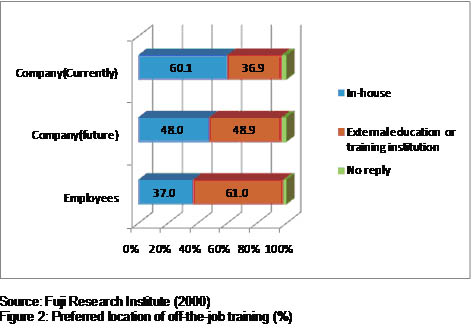
The collapse of the financial industry and other large companies has evoked increased anxiety in the labour market regarding sustainability of life time employment(Fujimura 2006). Employees now have a keen interest in developing their skills in order to be marketable in the external labour market. Firms & employees believe employees should be responsible for developing their own skills: 68% of firms taking part in the Fuji survey believed that customarily companies were responsible for training but 53.1% believe in future it will be the employee’s responsibility; 64.3% of employees believed they had responsibility for their training (Fuji, 2000). However, firms who remain committed to training their workforce tend to spend more of their training budget to train younger regular employees because they are more highly skilled, adaptive to technological changes and tend to be more productive than senior skilled workers.
Low growth reduced promotional opportunities within the firm, leading to intense rivalry among the workforce (Salmon, xxxx ). Firms began to change their promotion criteria from single hierarchical to permit promotion based on professionalism and specialist expertise. This occurred in a bid to reduce the trend of specialist workers trading their area of professional expertise for managerial appointments (Sako and Sato, 1997). There was also development of ‘ghost’ promotions, such as ‘kacho’ in which employees who would have been promoted in an era of soaring growth were given ‘promotion status’ (Salmon, xxxx). Promotion gave them managerial authority without any direct subordinates reporting to them (Debroux, 1997; Lincoln and Nakata, 1997). Management by objectives schemes are also increasingly used for appraising employees’ prospects, training and career advancement (Debroux, 2001).
Compensation Systems
Nenko based pay, which contributed to commitment and was central to life time employment, not only became expensive but also had the adverse effect of stifling creativity and zeal among young workers. The customary system, based on ‘corporate welfare’, is now considered obsolete and insufficient to meet the needs of both firms and employees (Haak, 2006; Debroux, 2006).
Reforms to nenko pay began in the 80s due to the ageing population in Japan, resulting in a shortage of younger workers that made the nenko based pay cheaper to maintain. However, low growth in the 90s, global competition and pressure on management to increase shareholder value due to the deregulation of industries, intensified the move from nenko to a more dynamic individual merit based compensation (Sano, 1993). This is presently mainly applied to managers or white collar workers because blue collar workers depend more on team performance as opposed to individualism (Berggren and Nomura, 1997). Some companies have aimed to develop approaches towards satisfying the demand of the younger workforce for recognition of individual merit. There is a combination of seniority and skill grading at the initial stage in their career, then when they move closer to managerial ranks, multiple pay-rate systems are used until they become eligible for future managerial performance related pay. See Table 3. (Debroux, 2001).
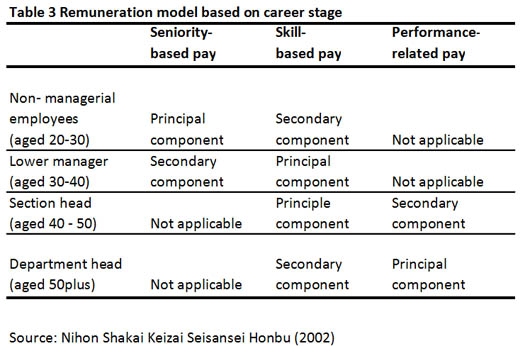
Companies are experiencing challenges with the reforms on compensation, such as lack of team spirit, reduced motivation and increased staff turnover (Lincoln and Nakata, 1997).
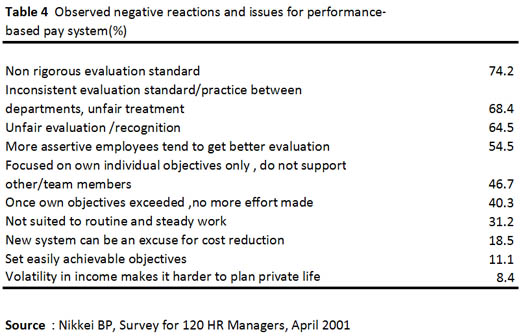
Performance based pay is also used to attract specialist skills, as in Toyota in 1994 when the company wanted to recruit car designers. It was clearly stated on the advertisement that salary would increase based on performance (Rosei Jiho, 1995). It is believed that the shift from nenko will increase as the percentage of regular workforces in big firms decreases (Berggren and Nomura, 1997).
Decision Making
Collective decision making was the norm under traditional Japanese management. However, new industries such as software, which became the one of the new source of competition for Japan, required ‘creativity, originality, unconventional solutions, breakthrough innovations, risk taking and radical change’ (Pudelko, 2006).
Japanese decision making has had to adopt to this new status by altering from its failure to respond speedily to being able to take radical actions which cannot be taken ‘collectively’. Top managers became more assertive in taking decisions that may be unwelcomed by many employees. Decision making in Japanese firms is now U shaped – descending from top down through the ranks and then back to the top again’. This indicates a synthesis of the old model with an Anglo-Saxon one. (Kono and Clegg, 2001)
Workforce Diversity
The changing lifestyle of the younger generation, many of whom now reject conventional industrial work ethics and prefer a freer lifestyle drifting between marginal and temporary jobs, has led firms to provide more socially diverse employment relationships. The NEET “Not in Education, Employment or Training) or freeters in 1992 were 1,010,000 but had more than doubled to 2,170,000 in 2005, reflecting growing unwillingness among young Japanese people to work like the older generation (Yuji, 2007). It is also important to note the rise in the two income family model, where over 60% of households now rely on two incomes resulting in an increase of female workers, many of whom are non-regular workers (Coulmas, 2006). There has been a rise in the percentage of female part-time workers from 19.3% in 1980 to 39.1% in 2001 (Ministry of Public Management, Home Affairs, Post and Telecommunications,2002). Table 5 shows the number of employees by type of employment, while Table 6 shows reasons for choosing the ‘non-regular worker form of employment’.
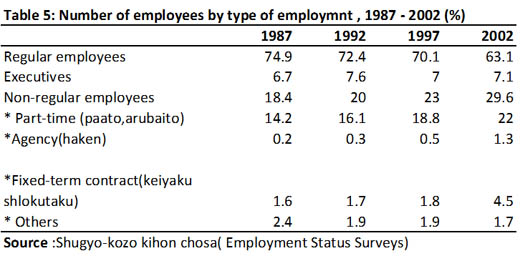
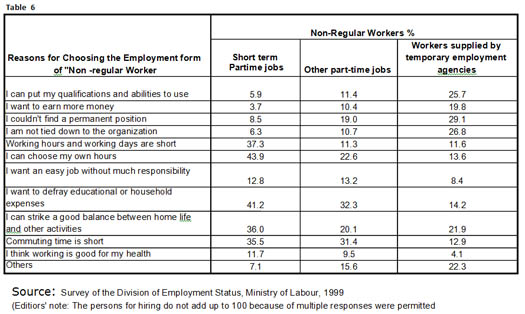
However, part-timers receive about 40-50% less than their regular counterparts, even when they perform almost the same amount of work ( EIU, 2005).
Labour Unions
Unionism has been declining for the past two decades, reaching as low as 19.2% in mid-2004 (compared with a peak of 55.8% in 1949). Factors responsible for this include industrial restructuring; increases in non-regular workers and service jobs and reluctance of the younger workforce. On the other hand, unions have also not placed unionisation of non-regular workers as a priority, being usually geared toward regular employees. The 1998 survey (Ministry of Labour 1998), among companies employing part-time workers shows that only 4.9% companies (totals based on industry and corporate size) unionise part-time workers, while remaining labour unions (95.1%) do not consider part-time workers as members.
Firms are also making efforts to improve channels of communication with their workforce through joint consultations and communication committees, as opposed to enterprise unions, while 46.3% are strongly opposed to unionisation of part-time workers (Nakamura et al., 1998). Unions have also accepted the use of performance related pay for employees, and suggested work sharing as a means of stabilising employment.
The role of the State
The aim of the government is to stabilise employment and foster equity within the workforce. Employers have been requested to use alternative options to dismissal and they are encouraged to do this with the provision of subsidies. Vocational skills training is provided to develop low skill workers. The worker dispatching law and employment security law have been relaxed so that both ‘worker dispatching and employment placement services’ can be easily carried out (Hepple, 2000). Amendment of the labour standard law in 1994 set the retirement age at 60, while it was adjusted to require ‘just cause to worker dismissals’ in 2003. Equality Opportunity law was enacted to improve working conditions for female workers. However, the soft approach to law enforcement relies on administrative guidance, which has not been effective (Hanami, 1998).
Conclusion
Evidenced above, it can be seen that the traditional HRM model was successful during economic growth. Due to economic decline and highly uncertain business environment, distinctive changes have been made. However, research by Morishama (1995) based on a sample of 1,618 companies, shows that 10.8% are making efforts towards changing from nenko to performance based pay structure and external recruitment; 32.4% are changing reward packages but maintaining life employment; while 56.8% still maintain the traditional HRM model. This indicates the rigidity of some old practices towards change. Japanese managers, government and unions still feel obliged to provide employment security. This explains the reason why changes have been gradual, carefully avoiding hasty breaks from the past (Selmer, 2001). However, while changes pointing to westernisation of Japanese management, especially in terms of a move to a more performance oriented management system, are evident in the new Japanese HRM, it is important to note that there are contextual differences (Dedoussis, 2004; Aoki, 1990) (see Table 6).
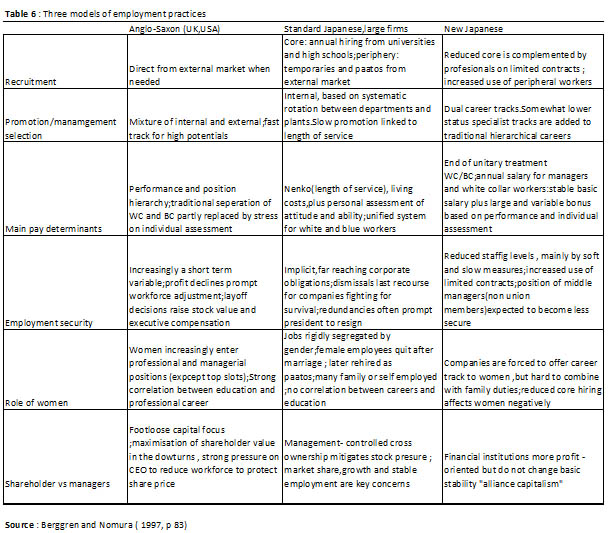
Whether substantial changes in Japanese management will take place in the longer term largely depends on pressures from globalisation, demographic changes, technological advancement, workforce diversification, economic recovery. However, despite the cliché of a ‘borderless economy’, there are background borders in the world which explains the reason for contextual diversity in approaches to employment adjustment in Japan (Yamakawa, 2003). I deduce that Japan is likely to blend continuity with change, gradually converging towards a pattern of international best practice in human resources management.
Blibliography
Ablegglen, J. And Stalk, G. 1985. Kaisha :The Japanese Corporation.Tokyo, Tuttle.
Aoki, 1990., “Toward an economic model of the Japanese firm”, Journal of Economic Literature, 28 (March), pp. 1-27.
BBC. 2001. Bubble trouble 2: changing the Japanese way, BBC Education and Learning .
Benson, J. and Debroux, P. 2004. “The changing nature of Japanese human resource management:The impact of the recession and the Asian financial crisis”, International Studies of Management and Organizations, 34(1), pp. 32-51
Breggren, C. and Nomura, M. 1997. The resilience of corporate Japan : new strategies and personnel practices. London: P. Chapman.
Boyles, C. J. 1993. “Jyosei no Kumiai-ishiki to Kanyu-kodo” (Women’s Perception of Unions and Actions to Join Unions). Eds. Toshiaki Tachibanaki and RENGO-RIALS. Rodo-kumiai no Keizai-gaku (The Economic Study of Labor Unions). Toyo Keizai Inc., pp.31-53, 1993.
Cabinet Office. 2004. Economic and Fiscal Policy (18 February).www.cao.go.jp.
Cole, R. E. 1973. Japanese blue collar: the changing tradition. Berkeley: University of California Press.
Coulmas, F. 2006. “Forward” in Haak, R. (Ed), The Changing Structure of Labour in Japan. Palgrave Macmillan .pg ix
Debroux, P. (1997), “Adjustment of human resource policies in Japanese companies”, Journal of General Management, Vol.23(1), pp. 23- 38.
Debroux, P. 2001. Unpublished survey on new appraisal, remuneration and career- development practices in Japanese companies.
Debroux, P. 2006. “The shift towards a performance – based management system from noryokushugi to seikashugi”, in Haak, R. (Ed), The Changing Structure of Labour in Japan. Palgrave Macmillan .pp.40-57
Dedoussis, V. 2001. “Keiretsu and management practices in Japan- resilience amid change”, Journal of Managerial Psychology. Vol. 16 (2), pg 1
Dore, R. 1973. British Factory – Japanese Factory .Berkeley, CA: University of California Press
Fuji Research Institute. 2000. Noryoku Kaihatsu to no Katsudo ni Torikumu tame no Choki Kyuka Seido no Donyu Sokusin ni Muketa Chosa Kenkya (Research Survey Aimed at Promoting the Introduction of a Long – Term Leave System for Developing Vocational Skills and Other Activities) Fuji Research Institute.
Fujimura, H. 2006. “Managing the development of one’s own vocational skills”, in Haak, R. (Ed), The Changing Structure of Labour in Japan. Palgrave Macmillan.pp.107-121
Haak, R. 2006. “Introduction : A view on Japanese human resource management”, in Haak, R. (Ed), The Changing Structure of Labour in Japan. Palgrave Macmillan.pp.1-9
Hanami, T. 1994. Managing Japanese Workers. Tokyo: The Japan Institute of Labour
Hepple, B. 2000. “The social dumping debate”, in Yamaguchi, K. et al. (eds.):
New trends of labour law in international horizon) pp. 441 and 446-467.
IMF. 2002. International Financial Statistics Year book. Washington, DC: International Monetary Fund.
Imai, J. and Shire, K. 2006.” Employment deregulation and the expanding market for temporary labour in Japan”, in Haak, R. (Ed), The Changing Structure of Labour in Japan. Palgrave Macmillan.
Koike, K. 1997. Human resource development. Tokyo: The Japan Institute of Labour.
Kono, T. and Clegg, S. 2001. Trends in Japanese Management. Continuing Strengths, Current Problems and Changing Priorities. Basingstoke and New York: Palgrave.
Kume, I.1998. Disparaged success : Labour politics in post-war Japan. Ithica, NY: Cornell University Press.
Lincoln, J. R. and Nakata, Y. 1997. “The transformation of the Japanese employment system”, Work and Occupations 24(1), pp 35-55.
Ministry of Labour. 1998. White Papers on Labour 1998. Tokyo : Ministry of Labour.
Moore, J. 1983. Japanese workers and the struggle for power 1945 – 1947. Madison, WI: University of Wisconsin Press.
Morishima, M. 1995. “Embedding HRM in a social context”, British Journal of Industrial Relations, December, pp.33-4
Nakumura, K. Hiroki S. And Takuhei, K. 1988. ” Rodo-kumai wa Honto ni Yaku ni Tatte iru no ka” (Are Labour Really Useful?).Labour Research Institute
Nihon Shakai keizai Seisansei Honbu 2001.Current Situation and Topics Concerning Japanese –Style Human Resources Management , Year book of the Human Resource Committee, 2001, Final Report of the study group of competence, appraisal of performance.
Nikkeiren. 1995. Nihonteki Keiei no Shin- jidai (A New Era for Japanese – Style Management) ( Tokyo : Nikkeiren Shuppanbu).
Nikkei BP. 2002. Survey of HR managers . Tokyo : BP
Organisation for Economic Cooperation and Development. 2001. Labour Force Statistics. Paris: Organisation for Economic Cooperation and Development .
Organisation for Economic Cooperation and Development. 2004. Economic Indicator (January) Paris: Organisation for Economic Cooperation and Development.
Osawa, M. 2001. “People in irregular modes of employment : Are they really not subject to discrimination?.” Social Science Japan Journal 4 (2), pp 183-199.
Pudelko, M. 2006. “Decision- making in Japanese companies”, in Haak, R. (Eds), The Changing Structure of Labour in Japan. Palgrave Macmillan.
Rosei Jiho.1995 ( 3 February) : 35 -7.
Sako, M. and Sato, H.1997. Japanese Labour and Management in Transition: Diversity, Flexibility, and Participation. Routledge, London. pp. 315-31
Salmon, J. 1999. “Rethinking Japanese HRM : Researching HRM. Where are we Going?”. paper presented to BUIRA conference.
Salmon, J. 2008. Diversified workforce lecture handout.
Sano, Y. 1993. “Changes and continued stability in Japanese HRM systems : choice in share economy”, The International Journal of Human Resources Management. 4 (1)
Sano, Y. 1998. “Human resource management in Japan”. in Poole, M. and Warner, M. (Eds), The IEBM Hand Book of Human Resource Management. Thomson Learning. pp 404-11
Sato, H. (1997), “Labour management relations in small and medium sized enterprises” in Sako, M. and Sato, H. (Eds), Japanese Labour and Management in Transition: Diversity, Flexibility, and Participation. Routledge, London. pp. 315-31
Sato, H. 2001. “Atypical employment: A source of flexible work opportunities?”. Social Science Japan Journal 4 (2) : 161 – 181.
Selmer, J. 2001. “Human resource management in Japan : Adjustment or transition?”, International Journal of Manpower 22 (3) . pp 235-43
The Economist Intelligence Unit Limited. 2005. “Human resources” in Japan Country Commerce. pp 80 – 88
Yamakawa, R. 2003. “Labour law and policy in an era of globalization : A Japanese report.”, in Jean-Pierre, L, Horiuchi, M and Sugeno, K. (Eds), Work in the Global Economy. pp. 171-82
Yuji, G. 2007. ” Jobless youths and the NEET problem in Japan “. Social Science Japan Journal 10 (1). Pp 23 – 40